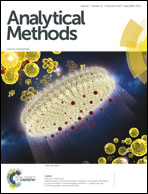Novel left-handed double-helical chiral carbon nanotubes for electrochemical biosensing study†
Abstract
Novel left-handed double-helical chiral carbon nanotubes (CCNTs) were one-step synthesized by carbonization of self-assembled chiral polypyrrole nanotubes, which came from the electrostatic interaction between carboxylic amphiphilic molecules and pyrrole monomers. Different samples were prepared through changing the carbonization temperature. These samples were characterized by scanning electron microscopy (SEM), transmission electron microscopy (TEM), N2 adsorption–desorption and X-ray photoelectron spectroscopy (XPS). We present the electrochemical biosensing performance of the prepared CCNTs by using dopamine (DA), ascorbic acid (AA), uric acid (UA), H2O2 and NADH as probes. CCNTs show high electrocatalytic activity towards the above molecules with a decrease of overpotential and a drastic enhancement of the anodic currents compared to ordinary carbon nanotubes. Moreover, the influence of carbonization temperature, pore size, different N-bonding configurations (pyridinic N, pyrrolic N and graphitic N) and surface area on electrocatalytic performance of the CCNTs was studied in detail. The results show that CCNT-900 with the largest BET surface area and suitable N-bonding configurations exhibits the best electrocatalytic activity. CCNTs with remarkable electrochemical biosensing capability may be a kind of promising nanomaterial for electrochemical biosensing applications.


 Please wait while we load your content...
Please wait while we load your content...